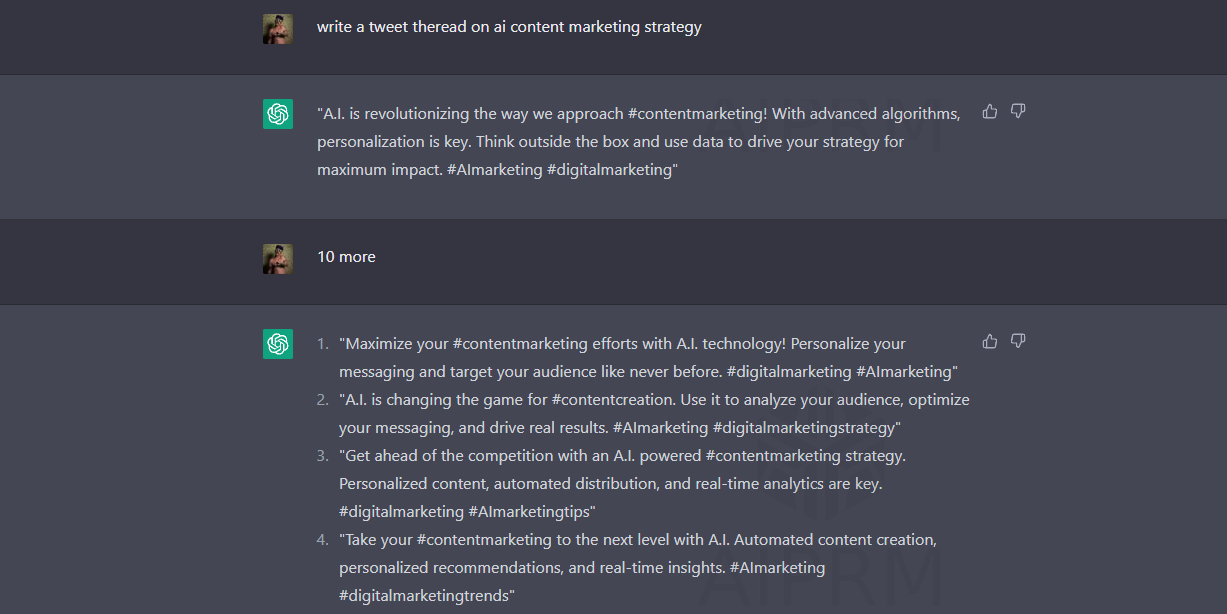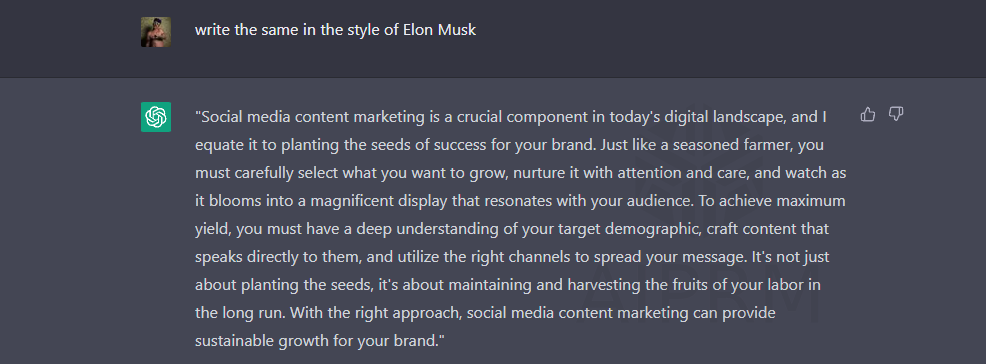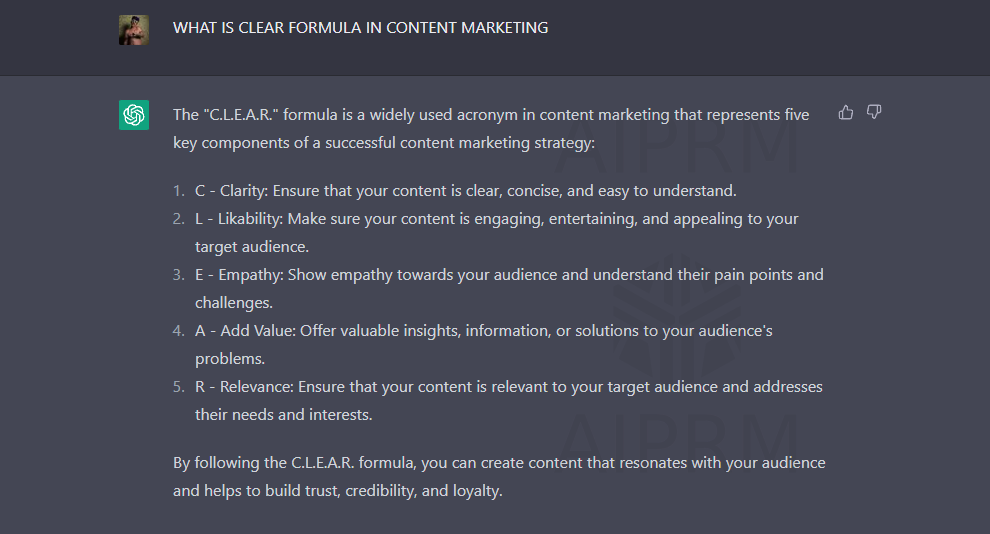Moreover, tech firms have a strong impact on what appears in users' conventional social media feeds. Their algorithms do not provide everyone with equal visibility; certain posts, such as videos, are given preference based on user habits, quality, and what individuals interact with most often.
Considering the large amount of noise on social media, fickle algorithms, and temperamental user involvement, how can you learn to write social media posts that will captivate your target audience and outlive algorithms?
It's a challenging goal, which is why companies spend a lot of money on their social media ads to guarantee they are seen by their intended viewers. But what if you don't need to invest in ads for success? Can expertly written copy do it instead? It's entirely feasible; there's even a formula for it! But first, let's consider why long-term accomplishments may not be achievable through social media alone.
|
TL;DR This plan outlines steps for creating effective content for social media sites using Artificial Intelligence (AI) writing tools. The focus is on understanding the target audience and their preferences, prioritizing content on the website, and investing in a content house for a long-term online presence. The AI writing process involves gathering information about the reader's interests and behavior, analyzing this data to produce captivating content, and continually adjusting it based on user engagement metrics. The benefits of using AI for social media posts include increased efficiency, enhanced quality, and reduced workload for human resources. The plan also emphasizes the importance of finding stories that fit the C.L.E.A.R. formula, using the CLEAR framework to write captivating stories, and maximizing content visibility through search engines. The final steps include advertising content on social networks, creating a sense of community, and communicating with the audience. |
Understanding and researching your target audience
To create effective content on social media. Aspects such as age, gender, hobbies, and locality are all key elements that should be taken into consideration. Having an understanding of who you are aiming your content at will enable you to make it engaging and pertinent, which is essential for gaining organic traffic from social networks.
After gaining a complete grasp on your target market, research the words they use to search for material online. This will assist in ensuring that your content is optimized for search engines and appears high up in the rankings when applicable keywords are used.
Prioritize content on your website before posting it to social media
 Let’s take a short break and discuss why social media should not be the main focus when it comes to content marketing. It is certainly essential to understand how to craft effective, concise messages for social media posts. This is an invaluable skill that will allow you to connect with your readers and share your main content located on the website.
Let’s take a short break and discuss why social media should not be the main focus when it comes to content marketing. It is certainly essential to understand how to craft effective, concise messages for social media posts. This is an invaluable skill that will allow you to connect with your readers and share your main content located on the website.
Your website is like a house that belongs only to you; you purchased it, paid for it and have complete control over its content and visibility. It’s not just the content you are creating and sharing on social media that is not yours to own — Instagram, Facebook, Twitter and LinkedIn are all owned by different people. Whether it be a billionaire like Elon Musk or a board of directors, they have their own agendas — which means your account can be disabled at any time and without warning.
Your posts may even be «shadowbanned», meaning they will no longer appear on hashtag pages, the explore page or in people’s feeds. Your content could be wiped out overnight if elon musk suddenly caused Twitter to collapse.
That’s why it’s so important to have your own content hub so that your presence online is guaranteed for the long-term. Investing in a content house should always take priority over posting anything on social media platforms. Apart from using social networks for websites, there’s an additional element that many other experts in my teaching don’t take into account.
Let us discuss this as it has a direct impact on the style of writing you’ll learn from me.
The reason why I coach individuals to compose lengthy social media posts and headings
Writing long social media posts is not only an option, it’s often the most effective way to get your message across. I’ve had the most success with captions on Instagram that exceed standard lengths — sometimes entire paragraphs versus just one or two sentences.
The trust between you and your followers is much stronger when you write longer messages. Whether it's for reels, LinkedIn, or Facebook, lengthy posts have a tendency to drive results. It’s been asked of me why I advocate for length in social media postings — I can recall a time when someone in our audience generated a lead from a post they made that was quite extended.
Proven to be true — length works! We conducted a study at TextScout comparing long-form content to its shorter equivalent, tracking outcomes such as leads, customers, and sales over a year. The results were spectacular — long-form had 62x more customers than short-form. We made over $200k in sales from long-form content while only one sale was recorded from short-form, with the customer eventually receiving a refund of 75%.

I emphasize the role of long-form content in building trust and generating sales. I have taught many solopreneurs to write stories for social media that brought them leads and sales within the same week. I have a strong conviction that your website should be the cornerstone of your real estate, but to create a path back to it, social media is an excellent venture. Make sure you have your website in top condition and your content house assembled for ultimate success. But without a doubt, utilize social media to become popular, likable, and dependable.
Exploring the Mechanisms of Artificial Intelligence Writing on Social Media Sites
AI writing on social media platforms works by using natural language processing (NLP) algorithms to generate content that is tailored to the user's interests and preferences. This content can be used to create personalized experiences and tailored messages, as well as identify trends in user behavior to better target advertisements.
The AI writing process starts with gathering information regarding the reader's interests, behaviors, and preferences. This data can be obtained by looking at social media accounts, website analytics, and other sources.
Next, the AI writing algorithm analyzes this data to decide on the best way to captivate and resonate with its readers. Factors such as user demographics, location, and language are taken into consideration when making this assessment.
It's time to produce the content. AI-driven writing applications make use of data and examination to build material that appeals immediately to the desired readership and fascinates them with pertinent and gripping information.
Finally, the AI composing program will continually adjust the content based on user engagement metrics and feedback, ensuring that the material stays relevant and efficient for a long time.
The Advantages of AI in Creating Tweet Threads for Social Networks
The utilization of AI writing for social media sites has several advantages. Here are some of the most impressive:
-
Greater efficiency: AI writing apps can produce material rapidly, allowing marketers and writers to construct captivating content that speaks to their audience in a prompt fashion.
-
Enhanced quality: AI writing algorithms are created to assess data and trends in their generated content, guaranteeing that the material produced is consistently top-notch. This helps elevate the general quality of content shared on social media platforms and raise interaction levels.
-
AI writing algorithms permit more tailored experiences by studying user data and behavior to generate content that speaks to the individual's interests and requirements.
-
Automated content production enabled by AI writing tools lightens the workload for human resources, granting marketers and content developers more time to focus on other facets of their jobs.

Threads are an efficient way to organize and present information. They can help make it easier to follow conversations, compare different points of view, and get a better understanding of complex topics. Threads can also be used to engage with others in a more meaningful way by responding to each other's posts and having more in-depth discussions. With the right approach, threading can be an effective tool for communication, collaboration, and learning.

Justin Welsh, the business owner of justinwelsh.me, was able to generate $1.2 million in income from 175 million views with the aid of a successful Twitter thread. He believes that producing captivating Twitter threads is an effective way to acquire potential followers who are interested in one's expertise. It's possible to use Chat GPT as a guide in formulating promising thread topics and creating quality content.
According to Justin Welsh, there are four crucial aspects to making a great Twitter thread:
-
Incorporate an attention-grabbing "hook tweet."
-
Avoid using headers in the body of tweets.
-
Break up long blocks of text into shorter, easier-to-read chunks.
-
End with a specific request or invitation for a dialog to encourage engagement.
Your hook is essential. To get the best outcome from Chat GPT and other AI writing systems, it needs to be trained through ongoing repetition and excellent input. Just take a look at this example! It was generated from content that I wrote, instead of starting with a blank page — direct inspiration from the all. Let's don our writer's cap!
Not too shabby, but it could be better. Let's use Chat GPT to take it up a notch. Shall we start with a catchy hook for this Twitter thread?
I asked Chat GPT for a more appealing hook and got: "Celebrate the power of storytelling with content marketing — a comprehensive guide to boost your brand and grow your business." After that, I rewrote the hook and ran it back through AI to get even better content than what I gave it.
Go ahead and take a look at the last sentence from Chat GPT — "From 10+ years in the game… to now leading the marketing charge" — that's really impressive copy. You have to make sure all your efforts fit inside one cohesive framework, so your readers are truly aligned with you and on board every step of the way.
An easy-to-follow system called the CLEAR formula can be used to construct social media posts
If you want to be successful with your social media posts, avoid writing that is unclear and filled with unnecessary details. You need to capture your readers' attention right away, as they are likely to keep scrolling if your post fails to engage them.
Having a plan for what you write is a good way of making sure that you get your point across and that it resonates with the reader. Just randomly writing something without first considering its impact is like shooting an arrow in the dark — there's no telling if it will hit its target.
To come out on top, you need to make sure that what you say has an effect on the reader (i.e., amuses, educates, or motivates them) and is written in a way that encourages people to read it!
The C.L.E.A.R. formula created by Jeff Hunter is a great way to maximize your message when it comes to social media posts. By cutting out the fluff and getting straight to the point, you can entertain, educate or empower someone with what you have to say and your story will get more attention. Jeff's businesses - Savage Marketer and VA Staffer - are a testament to his expertise in effective online communication, which I can personally vouch for. Every time I've used this formula when writing a post and sharing a narrative, it has been well-received as you're about to find out!
The focus of the C.L.E.A.R. formula is on story; this is essential to remember - you can succeed with social media writing through crafting an interesting and succinct narrative that serves your reader's needs. It's not just any type of narrative, it should be a way to deliver value through a captivating tale that produces outcomes. That's the takeaway, folks!
The C.L.E.A.R. formula is:
- Curiosity
- Lead-in Pitch
- Emotion
- Analyze/Front
- Reinforce/Reaction/Result
Before implementing this, it is important to make sure you have quality stories to place within the framework.
CLEAR formula example to create text
Curiosity: Have you ever wondered how to achieve success in life?
Lead-in Pitch: Well, research shows that there is a formula that can help you achieve your goals and reach success.
Emotion: Imagine being able to live the life you've always dreamt of, feeling fulfilled and accomplished.
Analyze/Front: The formula is called CLEAR and it consists of five key components.
Reinforce/Reaction/Result: By following the CLEAR formula, you can turn your dreams into reality and create the life you truly deserve. So, let's take a closer look at each component and see how you can put it into action.
How to Find Stories to Fit Inside the C.L.E.A.R. Formula
Discovering stories that work within the C.L.E.A.R. formula can be a challenge. This framework can help you come up with stories that will be entertaining and interesting to read. Begin by thinking of a topic that you would like to explore, and then look for a specific angle within that topic.
Once you have a focus, think of a way to make it emotionally appealing. Next, establish credibility by researching what authority figures have said about the topic, and then look for a resource that can provide evidence to support your viewpoint. Lastly, provide the reader with a resolution or action step that leaves the audience inspired. Through this process, you should be able to come up with an engaging story that fits inside the C.L.E.A.R. formula.
Discovering stories that fit within the parameters of the C.L.E.A.R. formula can be difficult. To make it easier, start by brainstorming a subject that intrigues you, and then search for a unique angle that can be explored. After that, strive to make the narrative emotionally stimulating. Subsequently, look for supporting evidence related to your chosen topic that comes from a reliable source. Finally, provide a resolution or action step that leaves the reader feeling inspired.
Prior to diving into the various parts of the storytelling process, you must come up with a subject that will captivate your audience. For instance, if I explained what I ate for breakfast this morning, that would not produce an interesting tale. However, if I discussed how my morning meal altered the course of my day, week, or month, this would be an intriguing topic.

Vulnerability
The CLEAR system helps you to convey your message concisely and compress your ideas so that you can inform, entertain, or inspire your audience effectively. It is like a blueprint for writing social media content that provides a structure to ensure the effectiveness of your narrative.
This framework was created by Jeff Hunter, an experienced marketer who runs his own companies, Savage Marketer and VA Staffer, and is successful at communicating effectively over the internet. From personal experience, I can confirm that this method works - whenever I have used this structure to write a social media post or tell a story, it has been well-received, as you will soon discover.

What is the distinction between the two subjects mentioned above?
The first topic doesn't require me to divulge any of my secrets, so I don't need to reveal much about myself. In comparison, the second topic is the total opposite. To share it authentically and accurately, I must willingly expose my personal traits. Doing this is greatly challenging for me.
By making myself vulnerable through sharing, I will be able to bring my audience closer. It will make me appear more humane, relatable, and real. This will help in creating a bond with those that I address, as it allows them to connect with me or the brand better. This is the goal of the process. Bearing this in mind, here are some ideas for sources of content which can be used within your CLEAR approach:
-
Engagements with ideal customers - what questions have they asked? What issues do you help them resolve?
-
The vulnerable truths of the brand and how they were overcome by you.
-
The preconceived notions that have been disproved or debunked in the industry.

Suggestions for Crafting Interesting Narratives to Share on Social Media Platforms
Reveal yourself. Delve into your inner self and share a story that is truly meaningful to you. If the story doesn't hold much significance, it isn't worth telling.
Results: 50K views on LinkedIn, 100 engagements on Facebook, 200+ engagements on Instagram. You must understand who you are writing for - know your target audience, including what they relate to, the language that resonates with them, and the challenges they face. Don't guess!
Focus on your hook. Your hook is everything - if it's not strong enough, people will scroll past your post. The curiosity you generate with those first words usually determines the overall success. So take time with the hook - experiment with phrasing and sentence structure, as well as the key ideas you convey in those critical lines (even changing a single verb or adjective can make a big difference). Create several versions until you find the strongest hook possible.
Follow the template. It works because it's effective. All of the posts I've written using this structure were well-received, and some even went viral, reaching hundreds of thousands of people!
Have someone else review it. Share your concise story with a trusted friend or colleague to get their perspective. Your eyes can miss things, so don't hesitate to ask for feedback or suggested edits before publishing your post.
Write Your C.L.E.A.R. Story
Now that you have an interesting tale, it's time to structure it using the CLEAR framework. Let's go through this step by step using a real story I posted on social media that ended up becoming popular. I told an open and honest narrative about the strain of procuring a great writer.
- Curiosity
This is the opening line of your post - the bait, the headline, the attention grabber. It must arouse curiosity in your viewers, grabbing them and not letting go. You must quickly have people stop their scrolling with your hook and keep it brief. Try to express it in a few words or one sentence, utilizing your language skills to make sure you are eliminating any superfluous words. "I failed" (the hook I actually used).
We can reduce the first sentence of our opening to the more effective "It sucked". In this way, the hook is punchier, quickly conveying the desired message. Don't be afraid to edit your paragraphs and sentences in order to maximize the impact of your writing.
- Lead-in Pitch
Consider your introduction as the fishing line connected to your hook. The hook is what captures them, but the introduction is what draws them in. After reading this part, the reader should want to learn more and continue reading. Normally, keep your lead-in pitch to a few sentences (ideally 1-2). These should carry on emphasizing and/or clarifying the concept, atmosphere, feeling, or declaration you said in your hook, stretching out that curiosity into interest.
My "it sucked" could be "It was a big challenge." From here, I answer the questions "WHAT sucked and WHY? I create a scene that establishes what my post is about. I write in a relatable way to my target audience, who have probably dealt with the same issue. How do I make this relatable? I piggyback off of my lead-in pitch. Let your lead-in pitch set the scene as you draw them in: "Do you think I sound like a writer anymore? The post starts out in a relatable way to my target audience. Fluffy: "I sucked." This can be cut down to: The post starts out in a relatable way to my target audience. Do you think I sound like a writer anymore? How do I make this relatable?
Let your lead-in pitch set the scene as you draw them in: "I'm a writer, but I suck at writing social media posts. That's not a social media issue, that's actually a human problem. So I'm writing about that. Fluffy: "There was no doubt about it. It sucked."
- Emotion
Next, analyze the emotion in the story you’re narrating. Consider your lure and introduction in your presentation and think to yourself, "what did it provoke within me? How did it impact me?" Keep this really concise. A single sentence or even a sole word can make a major difference here. Bearing that in mind, be discerning with your verbs and adjectives: opt for the power-packed ones. Strike out any limp words that don’t convey the intensity of the sentiment you’re relaying. For example, "they displayed notable aptitude in their craft right away. But: they were completely taken aback."
What are my powerhouses in this sentence? "Massive" (referring to the talent of the writer whose training was extensive) and "blindsided" (referring to how I was so eager to have them on my team that I was blind to the fact that they weren't a good fit). Visualize for a minute that I had chosen weaker words to use in this line. For example, "noticed a lot of skill in their work early on, but I was flying." Can you see the difference in the power and effect of the emotion I'm conveying just by exchanging two words? Similarly, search for weak words in your writing and replace them with powerful ones that can strongly affect your reader. Ultimately, the instances of education were indicative of this: talent is important, but unless you are willing to take risks, persist in the face of adversity, and accept the need for change, it is unlikely that you will succeed.
It is essential, particularly for the sentiment facet of the CLEAR formula, to avoid any weak expressions combined with an intensifier such as "really" and substitute them with powerful adjectives that can convey the meaning in one word. However, it is also a good practice for all your descriptive writing. Otherwise, your skill will end up abandoned.
In Gary Halpert's Boron Letters, he stated that enthusiasm triumphs over talent every single time. In Grit, renowned scholar and professor Dr. Angela Duckworth asserts that success does not come from ability but rather from perseverance. It is evident that I am conveying what I have learned from the experience of recruiting a competent author, only to be obliged to let them go. The key lesson that I learned is that aptitude has no value if there is no suitable attitude. To further corroborate this fact, two books by specialists provided me with external evidence. Therefore, I am disclosing additional verification that this insight is universal and not just based on my own knowledge.
In this section, you should delve into the insights and thought-provoking revelations that have come about because of your experiences. These can include your opinions based on literature you've read, facts from relevant studies, quotes from an authority, or stories from your own past that made an impression on you. When writing here, keep your language precise and use only the most impactful points.
- Analyze/Proof
This is the central point of your CLEAR post; this is where you will explain and demonstrate your argument in 2-6 sentences. After exploring what you learned, what was the main understanding? To illustrate, here's an example: No matter how skilled or talented you may be, if your outlook is not right and you are not willing to strive harder, take risks, and accept change, all your talent will come to nothing.
As Gary Halpert said in his famous Boron Letters, enthusiasm always trumps talent. Similarly, the noted researcher and professor Dr. Angela Duckworth demonstrated through her book Grit that success does not necessarily stem from natural ability but rather from perseverance.
In this section, it's a great opportunity to reflect on what you learned from employing a very talented writer only to ultimately assign them another task. The core of the lesson (skill means nothing if they have the wrong attitude) was bolstered by two books written by professionals that further revealed that this truth is universal.
It's an occasion to explore deeper into this knowledge and what other revelations you can find in relation to it. This could be any facts or figures from related research, the advice of an acclaimed expert, or other past experiences that didn't click until now. In this section, it's essential to be succinct. Compose what you want to express, then trim it down until only the most essential details remain. Give yourself enough time for evaluation
- Reinforce/Reaction/Result/Proof
After your investigation, it's an ideal opportunity to impart the outcomes of what you found and how you reacted in 1-3 sentences. Simultaneously, you'll be strengthening your underlying introduction. This is a chance to powerfully express the primary realizations from your other clear segments. It's additionally somewhat future-centered: how will this experience shape your methodology later on? How has it adjusted you for eternity?
Example: "I have read a few books I quilted. Be that as it may, I keep on learning in the most difficult way conceivable. Take my recommendation - tenacity, determination, and the correct attitude consistently outflank ability." We coached and guided authors who were at the peak of their abilities, but when we looked back, they didn't display any aptitude. They tackled the task with tremendous work ethic.
Maximizing the visibility of your content through search engines
To achieve a high ranking on social media sites, it's indispensable to ensure your content is tailored for search engines. This means taking into consideration the correct keywords for both headings and text, as well as ensuring that your material is organized and easy to read.
When picking the right keywords, it's important to use them in a manner that sounds logical within the context of your writing. Try not to stuff too many keywords as this could have an adverse effect on your search engine rankings. With regards to organization, you should include subheadings, bullets, and numbered lists, which will make it easier for readers to go through while also helping search engines recognize the arrangement of your content and making it simpler for them to examine and index.
Advertising your content on Social Networks
Ultimately, it's necessary to advertise your content on social media platforms to extend its reach. This can be done through both commercial advertisements, as well as employing organic methods such as sharing your content with existing followers and encouraging them to share with others.
Furthermore, you should communicate with your audience and reply to any inquiries or remarks that may be submitted. This will create a sense of community concerning your company and will motivate others to stay current and participate with your material.

Assemble all the pieces to form a complete whole
Once you have written each section of your clear post, it's time to bring them all together. Keep refining the post for continuity, conciseness, and effect; look for any verbose phrases and refine them to make them more concise. Replace any feeble words with much more powerful ones and reword any thoughts or expressions that are confusing. After doing all this, rejoice! You have just put together your first clear social media post - so now you can see the complete picture in action. Here is my clear story, with all its components put together!





Тут еще никто ничего не писал, стань первым!